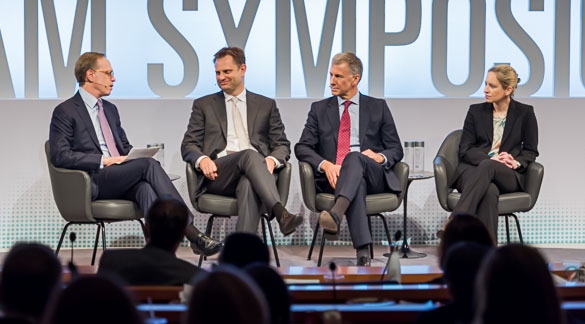David Klassen, United Church Funds’ Chief Investment Strategist, recently contributed to the influential Goldman Sachs Asset Management Symposium, speaking on “The Future of ESG and Impact Investing.”

R-L:
Taylor Jordan, Head of AIMS Imprint, Goldman Sachs
David Klassen, Chief Investment Strategist, United Church Funds
Elizabeth Lewis, Head of Sustainable Investing, World Resources Institute
Moderated by: Hugh Lawson, Global Head of GSAM Institutional Client Strategy, Goldman Sachs
ESG and Impact investing is no longer a philanthropic experiment, but is increasingly seen as an extension of traditional, rigorous investing with an additional focus on positive impact in the world. Panelists discussed key opportunities and challenges in ESG and Impact investing, and shared insights on practicalities around implementation.
ESG and Impact Investing is at an inflection point in being incorporated into holistic investment strategies. All panelists recognized that there is far more to ESG and impact investing than just negative screening of investments. Jordan described his approach of incorporating 12 ESG themes into investments to identify opportunities. Integrating such a comprehensive ESG approach is a difficult problem that requires commitment from all levels of an organization. Importantly, ESG and Impact investing is about a total process, not just about an endpoint.
ESG and Impact Investing is about making better investment decisions. As Klassen said, “we are not willing to sacrifice returns for this.” Recent studies have shown positive links between financial returns and ESG impact. The move away from merely screening out ‘sin stocks’ allows investors to expand their opportunities, using more qualitative data on ESG and Impact investing to make better investment decisions. A good investment is one where financial metrics and ESG and Impact metrics are aligned. The common theme is to seek value.
There is no one-size-fits-all approach to ESG and Impact Investing. Our panelists emphasized the range of approaches to incorporating ESG and Impact considerations into their processes. Some use separate investment committees (IC), others look to incorporate their social and responsibility committees into their ICs. Some use enhanced index funds, others look to track qualitative metrics across investments on an annual basis. One core theme was a desire for better data and transparency to help assess organizations’ and investments’ merits consistently.
The views expressed are solely those of the speaker(s) for “The Future of ESG and Impact Investing” panel from the 2017 GSAM Symposium and do not necessarily reflect the views of The Goldman Sachs Group, Inc. or its affiliates. The views presented should not be taken as investment advice, an endorsement or recommendation of The Goldman Sachs Group, Inc. or its affiliates. Views provided are as of April 4-5, 2017 and the Goldman Sachs Group, Inc. or its affiliates have no obligation to provide updates or changes. This material and the views and opinions expressed herein are for informational purposes only and do not constitute research, investment advice, or an offer or solicitation to buy or sell securities. Although certain information has been obtained from sources believed to be reliable, we do not guarantee its accuracy, completeness or fairness. We have relied upon and assumed without independent verification, the accuracy and completeness of all information available from public sources. Economic, Social, and Governance (“ESG”) strategies may take risks or eliminate exposures found in other strategies or broad market benchmarks that may cause performance to diverge from the performance of these other strategies or market benchmarks. ESG strategies will be subject to the risks associated with their underlying investments’ asset classes.